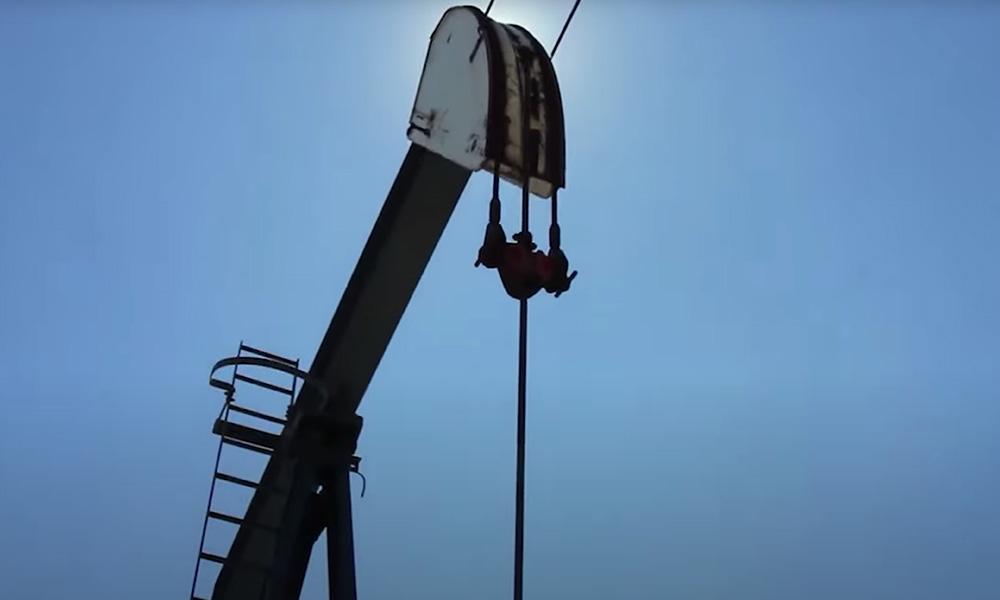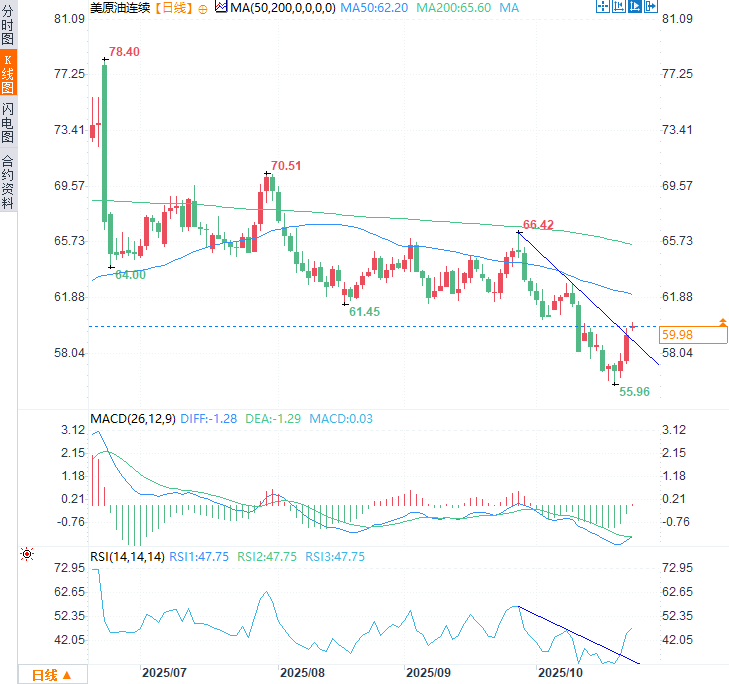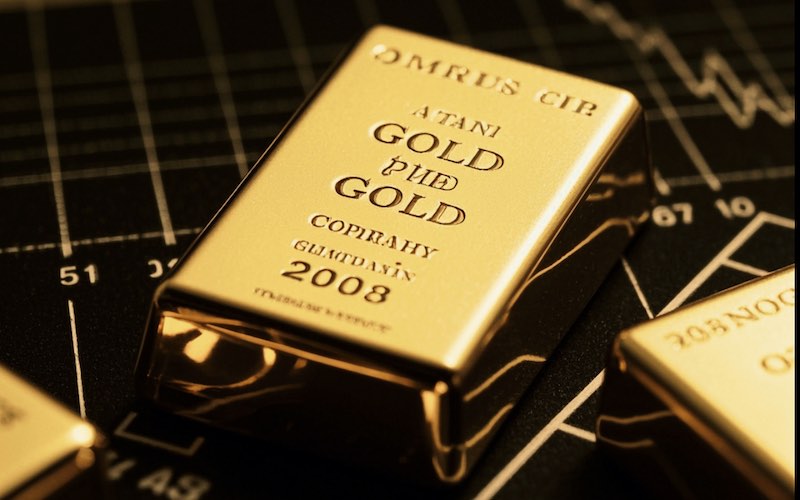Trump cancels meeting, imposes new sanctions on Rosneft, and Putin conducts nuclear exercises, sending oil prices soaring to a two-week high.
2025-10-23 11:33:09
In Asian trading on Thursday (October 23), WTI crude oil largely held onto its gains from the previous two trading days and continued its upward trend, rising as much as 3.3% to a two-week high of $60.42 per barrel. It is currently trading around $60.15 per barrel, up approximately 2.82% on the day. On Wednesday, WTI crude oil rose over 3%, its largest single-day gain in nearly 11 weeks.

Trump says he has canceled his summit with Putin, complaining that negotiations have reached an impasse
U.S. President Donald Trump said on Wednesday he had canceled a planned summit with Russian President Vladimir Putin, citing a lack of progress in diplomatic efforts and inappropriate timing.
"We canceled our meeting with President Putin. I didn't feel it was appropriate, I didn't feel we could achieve what we had to achieve. So I canceled it, but we'll reschedule it in the future," Trump told reporters at the White House.
Trump also expressed frustration with the deadlock in the negotiations, saying: "Frankly, I can only say that every time I talk to Vladimir (Putin), the conversation goes well, but then it goes nowhere."
The summit cancellation came as the White House announced new sanctions on Russian oil exports, which Trump said he hoped would be temporary.
Trump says he doesn't want a futile meeting
Russia and Ukraine launched heavy missile attacks on each other overnight, throwing peace efforts into renewed uncertainty.
After months of diplomatic stagnation, Putin and Trump spoke last week and unexpectedly announced a summit in Hungary. But Trump said he did not want a "futile meeting," and the Kremlin said Putin also wanted to avoid such a situation.
NATO Secretary-General Mark Rutte said before his meeting with Trump on Wednesday that he was "quite confident" an agreement to end the conflict could eventually be reached.
Rutte told reporters after meeting with lawmakers in the U.S. Senate that he had "full confidence" in Trump, adding that the president "has a clear vision for a lasting end to this conflict."
Rutte said U.S. allies were working "very hard" to push for Trump's initiative to provide weapons to Ukraine at the allies' expense.
Rutte praised Trump for brokering a ceasefire in Gaza and said Trump hopes to achieve a similar outcome on Ukraine. "I can't predict the specific steps now, but it will obviously involve a lot of discussions. It won't end tomorrow, but I'm quite confident we can achieve our goals."
Russia reiterated to the United States its previous conditions for a peace agreement with Ukraine, including that Ukraine must give up control of the entire southeastern Donbas region.
This tantamount to denying Trump's proposal last week that "both sides should cease fire on the current front." Russian state news agency RIA Novosti quoted Russian Deputy Foreign Minister Sergei Ryabkov as saying he could not confirm that Moscow had conveyed this position to the US.
Russia holds nuclear exercises
Russia said on Wednesday it had conducted a large-scale exercise involving nuclear weapons, a day after the United States postponed a planned second summit between Trump and Putin to discuss the conflict between Russia and Ukraine.
The Kremlin released a video showing Russian General Staff Chief Gerasimov briefing Putin on the exercises. Russia said the exercises involved the launch of missiles from land, sea and air bases, including intercontinental ballistic missiles capable of striking the United States.
To further demonstrate its strength, the Russian Ministry of Defense stated that its long-range Tu-22M3 strategic bomber flew over the Baltic Sea and was accompanied by foreign fighter jets, which were presumably from NATO member states.
At key moments in the Russia-Ukraine conflict, Putin has repeatedly reminded Kyiv and its Western allies that Russia possesses nuclear capabilities, and NATO also conducted nuclear deterrence exercises this month.
Sweden said on Wednesday it had signed a letter of intent to export Gripen fighter jets to Ukraine, as European governments move to bolster Kyiv's defenses.
Ukrainian President Volodymyr Zelensky said during a visit to Swedish defense manufacturer Saab SAABb.ST that Ukraine plans to receive and start using the Gripen fighter jets next year and expects to purchase at least 100 of them.
Trump says U.S. did not authorize Ukraine to use long-range missiles
The Wall Street Journal earlier reported, citing unnamed U.S. officials, that the Trump administration had lifted sanctions on Ukraine for using long-range missiles, some of which were supplied by Western allies.
Trump said on Wednesday that news reports that the United States approved Ukraine's use of long-range missiles to strike deep into Russia were false, adding that the United States had nothing to do with the missiles.
Kremlin says Putin will not attend G20 summit in South Africa
Russian President Vladimir Putin will not travel to South Africa for the November 22-23 G20 summit in Johannesburg, but Russia will send a high-level representative, the Kremlin said on Wednesday.
US imposes sanctions on Russia's two largest oil companies
Trump on Wednesday imposed sanctions on Russia for the first time in his second term over the conflict with Ukraine, targeting Lukoil and Rosneft, amid growing frustration with Russian President Vladimir Putin over the conflict.
The U.S. Treasury Department said it was prepared to take further action and called on Moscow to immediately agree to a ceasefire in Ukraine.
"Given President Putin's refusal to end this senseless conflict, Treasury has decided to sanction two of Russia's largest oil companies for funding the Kremlin's conflict machine," Treasury Secretary Besant said in a statement. "We encourage our allies to join us in implementing and adhering to these sanctions."
The sanctions are a significant policy shift for Trump, who previously refrained from imposing sanctions on Russia over the conflict with Ukraine, relying instead on trade measures. Trump imposed an additional 25% tariff on goods from India in retaliation for India's purchase of Russian oil.
Western countries imposed a price cap of $60 per barrel on Russian oil after the start of the Russia-Ukraine conflict. In recent years, Asia has replaced Europe as Russia's oil customer.
Trump said last year he wanted sanctions lifted quickly because they risked the dollar's dominance in global oil trading. Russia has frequently demanded payment in other currencies.
Not a one-time solution
Trump's move on Wednesday followed sanctions imposed by Britain last week on Rosneft and Lukoil.
Analysts say the measures are a big step but long overdue.
“This is not going to be a one-time fix,” said Edward Fishman, a former U.S. official and now a senior research scholar at Columbia University. The question, he said, is whether the U.S. will now threaten sanctions against anyone doing business with the two companies.
Jeremy Paner, a former sanctions investigator at the Treasury Department and now a partner at the law firm Hughes Hubbard & Reed, said the sanctions announced Wednesday did not involve banks or Indian or Chinese oil buyers, which "would not concern Putin."
But a senior Ukrainian official said the step was "good news" for the two Russian oil companies, which are the targets of U.S. sanctions requested by Kyiv.
Russia's embassy in the United States and mission to the United Nations did not immediately respond to requests for comment on the sanctions.
After the sanctions announcement, international oil prices rose by 3%.
"It is time to stop the killing, to institute an immediate ceasefire," U.S. Treasury Secretary Scott Besant said in announcing the sanctions on Rosneft and Lukoil.
He stressed: "Treasury is prepared to take further action, if necessary, to support President Trump's efforts to end another conflict. We urge our allies to join and abide by these sanctions."
The Treasury Department said the new sanctions would undermine the Kremlin's ability to raise funds for the Russia-Ukraine conflict. A senior White House official told NBC News that the sanctions were linked to the cancellation of a planned meeting between President Trump and Russian leader Vladimir Putin in Budapest.
U.S. crude oil prices surged by about 3% on Wednesday evening after the Trump administration imposed further sanctions on two Russian oil giants on the grounds that "Russia lacks a serious peace commitment to end the Russia-Ukraine conflict."
Even before the announcement of the new round of sanctions, the crude oil futures curve was already in contango, reflecting weaker demand relative to available supply. While that curve has now inverted, it immediately raises questions about the sustainability of the rally—especially when fundamentals don't justify the current premium driven by geopolitical risks.
With geopolitical tensions flaring up again, the question now is whether the ongoing rally in U.S. crude oil has staying power or will, as has happened so many times before, be just another short-lived knee-jerk rally that eventually fades.
US crude oil prices have fallen 16% this year, while Brent crude has fallen nearly 14%. The OPEC+ alliance, led by Saudi Arabia and Russia, has been increasing production for months. Meanwhile, trade tensions sparked by Trump's tariff policies have exacerbated oil market concerns about slowing economic growth and dampening crude oil demand.
U.S. crude oil continues to break through the downward trend line
Even before the news, there were signs that the directional risk for US crude oil's continuation was tilted upward. Earlier this week, a series of hammer candlestick patterns formed above a known support area on the daily chart. This was followed by the formation of a bullish engulfing candlestick pattern on Wednesday, before the news sent prices sharply higher in early Asian trading on Thursday, breaking out of the downtrend that had been in place since late September.
Prices are currently blocked at $60.50 per barrel, which served as both support and resistance for a long period of time earlier this year.
On the upside, given the previous bullish technical signals and positive news, if oil prices effectively break through the resistance of $60.50, the next target could be around $62.20 (coinciding with the 50-day moving average). Subsequent targets could focus on the October high of $63, the $65 resistance level, or the key 200-day moving average (65.60).
On the downside, if oil prices fail to effectively hold above $60.50, it may strengthen the bearish trend, making $58 and $56 jointly potential downside targets.
While the Relative Strength Index (RSI14) and the MACD indicator remain bearish, overall momentum suggests that downward momentum is rapidly fading. The RSI (14) has broken through its downtrend line and is rapidly approaching its 50-day neutral level. The MACD histogram, while still in negative territory, has also turned closer to its signal line. Given that the current market is driven by headlines, it is recommended to focus more on price action analysis itself in this environment.

(U.S. crude oil continuous daily chart, source: Yihuitong)
At 11:32 Beijing time, U.S. crude oil continued to trade at $60.04 per barrel.
- Risk Warning and Disclaimer
- The market involves risk, and trading may not be suitable for all investors. This article is for reference only and does not constitute personal investment advice, nor does it take into account certain users’ specific investment objectives, financial situation, or other needs. Any investment decisions made based on this information are at your own risk.





















